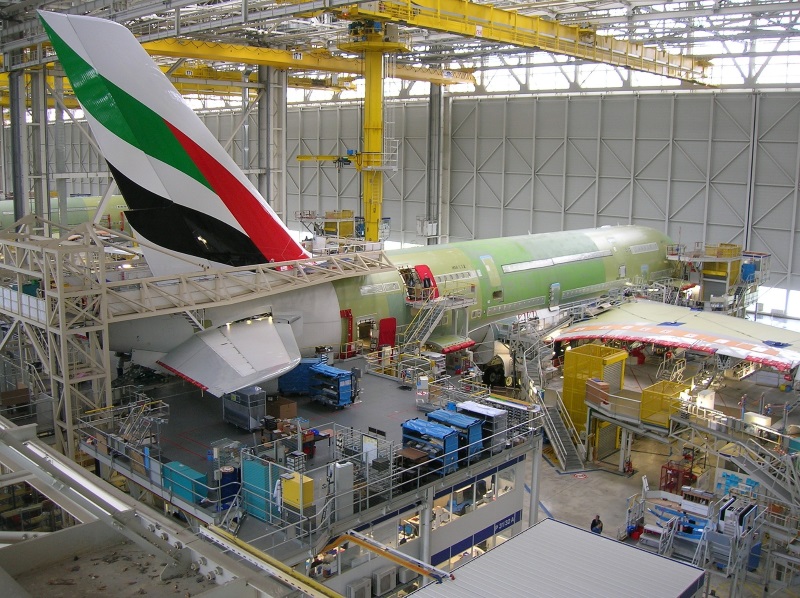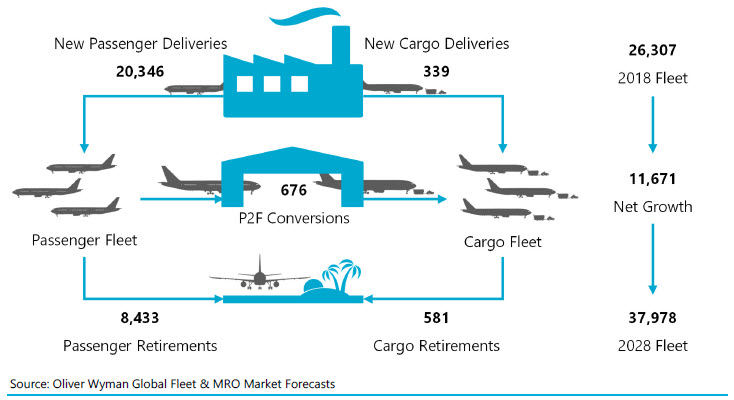Remember when back in the day, only the privileged few were able to board a plane and travel the world?
Nowadays, we witness the results of a number of aerospace revolutions that have turned plane tickets into a commodity and a very affordable and common purchase.
In the next 20 years, airline traffic will more than double and according to industry predictions, we can expect to see a 3.7% net annual growth in the number of active aircrafts over the next decade. Many more people fly a lot more often, and this trend is getting stronger by the minute.
Here’s an infographic that presents 2018-2019 benchmarks:
While having the opportunity to meet with business peers, visit far-away destinations and experience foreign cultures is a wonderful thing, behind the scenes, the aerospace manufacturing industry faces enormous pressures to deliver the parts needed to keep this machine going. That’s the “throughput challenge”.
Not only that, but production technologies and techniques are constantly improving and factories are required to create better quality parts using more advanced materials in a shorter space of time.
An industry responsible for the safety of billions of travelers worldwide cannot cut corners or reduce its quality standards in any way. Obviously, apart of the strict regulations, doing so might end in awful tragedies that can also cause a PR crisis as recently experienced by Boeing.
I believe that this makes the issue of throughput a key industry challenge that is impossible to win without industry 4.0 technologies. After years of collaboration in the field, I am here sharing a number of valuable examples of aerospace manufacturing throughput challenges that shed light on the role of advanced Industry 4.0 technologies.
A well-oiled machine: Overall Equipment Effectiveness Optimization
What are aerospace manufacturers to do in order to deal with the increase in demand? The initial thought might be that in order to keep up with the latest advancements and global growing demand, manufacturers should build new sites, purchase machines and physically expand their business. But, obviously this strategy is extremely costly and it should be considered only after maximizing the existing elements of the manufacturing equation.
Before buying new machines (and expanding the production floor to hold them) let’s first examine our current machine’s efficiency levels, or Overall Equipment Effectiveness (OEE). Chances are we’ll find that some machines stand idly by due to different issues that bring the workflow to a halt. These include material identification and categorizing, manual quality checks and approvals, human errors leading to delays, and more.
Still today, in many factories, machines end up working only 45% of the time, even though they are perfectly ready and able. 100% work time is not feasible, of course, but there’s a lot of progress to be made from 45%…
For instance: “Unplanned downtime costs industrial manufacturers an estimated $50 billion annually. Equipment failure is the cause of 42% of this unplanned downtime.
Industry 4.0 solutions, and specifically AI based IIoT optimization solution can. 1. Identify issues that stand in the way of maximizing machinery work, and 2. Automate procedures to minimize delays and to maximize the production capabilities of each machine. Here’s how:
- Material Loading: AI-based solutions allow manufacturers to optimize the scheduling of material loading times and quality-control procedures. Every step of the material management process becomes faster and more efficient thanks to RFID readers that instantly identify each material and offer the best way to handle it. This includes, for example, scheduling the right times for frozen materials to be taken out in order for them to become available right when they are needed.
- Machine Maintenance: Even the most advanced machines need preventive and periodic maintenance. With AI, manufacturers can better schedule these procedures, especially if they translate to machine downtime. In addition, they are able to optimize the work hours of related technicians.
- Tool Maintenance and Service: the same goes for a variety of tools and molds that are used during the manufacturing process and require maintenance, cleaning and calibration to ensure production of qualified parts, avoiding quality issues.
The 4th industrial revolution connects the dots by following each part or material, and if we still find that purchasing new machines is needed, we’ll have clear ROI evidence to support this purchase.
Make it work: Reducing rework
The aerospace industry standards demand that materials used in the manufacturing process pass strict quality control tests and receive the appropriate approvals before they are implemented. Getting a single step wrong could mean having to repeat an entire procedure, wasting valuable time and expensive materials and facing delays in production. This is directly related to the throughput challenge.
In some cases, apart from the throughput pain, time sensitive material such as CFRP (Carbon Fiber Reinforced Polymers) go to waste simply because of miscalculations their expiration date or exposure time. Rework can be reduced and prevented through AI and industry 4.0 solutions. For example:
- Automatically monitoring material exposure times for quality control purposes, in order to prevent any usage of expired materials, which might require the recreation of the same parts. Having all of the information regarding each material instantly available enables manufacturers to identify and optimize the work procedures in advance.
- Thanks to IoT sensors and cloud software, manufacturers can unify and manage orders so that time, work and materials are saved along the way. Instead of repeating the same process for different parts, all relevant parts are combined into a single-step digital and automated process.
- AI techniques are used to constantly analyze historical data and offer optimization, smart predictions of late work orders and potential quality issues.
- Manufacturers are not only able to meet the same goals in less time, but they can also scale up and increase their efficiency without creating any extra pressure or added errors. It’s first-try production all the way.
Power to the people: Maximizing the workforce
The production floor workers make not only an expensive resource but also a key in winning the throughput challenge.
Failing to optimize the workforce efficiency costs aerospace manufacturers a great deal each year and makes everyone, including workers themselves, less happy.
How can technology help? Here’s just one example:
According to a leading aerospace manufacturing customer of ours, 25% of workers’ time is dedicated to manually-reporting tasks instead of the production work they were hired and professionally trained to do.
When there’s a need to optimize throughput, instead of hiring and training more employees, manufacturers should focus on deploying technologies that free workers from unproductive reporting procedures and allowing their workforce to focus on their actual production job. Once again, they will save the time these tasks require, minimize the errors involved in completing them, and solve the pain of taking workers away from their core tasks.
As a positive byproduct, with each step tracked and monitored by software solutions using AI, the company’s (machine) learning capabilities will grow stronger and support every other step of the manufacturing process. Predicting trends and managing inventory will become much easier and far more accurate.
How is that done specifically? When industry 4.0 is onboard successfully, multiple data is automatically tracked, collected and stored in the cloud.
Too much of a good thing: Inventory optimization
When it comes to the issue of inventory, we all know that running out of stock – a lack of required parts or materials – is a major risk to any production operations. Companies are usually coping with this by holding excessive inventory and WIP (Work in Process) which adds significant costs and slows down production.
With unnecessary parts expiring, blocking the way and constantly being misplaced, companies lose precious time and a lot of money due to poorly managed inventory.
Once again, inventory optimization is a classic challenge for AI, as these systems are running smart predictions and can forecast the amount of inventory to be consumed against the inventory level tracked using smart IoT sensors in real-time, not less and not more. These calculations are almost impossible to run without proper AI, let alone the dynamic nature of production demand.
Don’t let me down: Downtime minimization
We cannot cover the core issues without at least mentioning the topic of legacy systems’ downtime, which is heavily related to lost machine time and work hours. By working with innovative cloud software, aerospace manufacturers are able to march even outdated systems forward and track production using advanced cloud-connected sensors and SaaS based software offering redundancy and higher availability rates than the older IT systems you are using today.
Summary
The throughput challenge in the aerospace manufacturing industry is a key one that is only expected to grow, facing the travel trends and the solid forecasts that are provided by all relevant players.
Manufacturers are struggling to maximize the potential of their existing resources before running to build new production sites, purchase new machinery and increase the workforce.
They must optimize their existing operation in order to maintain and grow the profit. This can be done ONLY by leveraging industry 4.0 AI-based technology.
Apart from their key role in overcoming the throughput challenge, these technologies present solid ROI, as explained in detail here.












